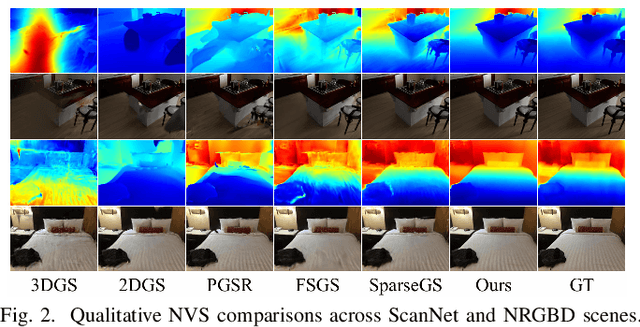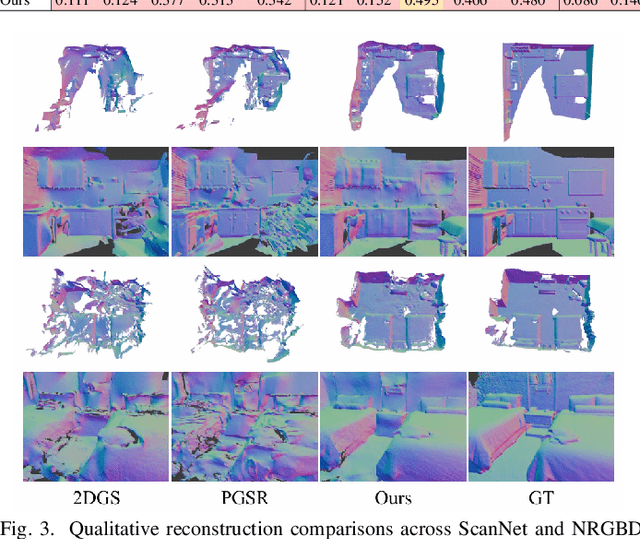Houqiang Zhong
PrismGS: Physically-Grounded Anti-Aliasing for High-Fidelity Large-Scale 3D Gaussian Splatting
Oct 09, 2025Abstract:3D Gaussian Splatting (3DGS) has recently enabled real-time photorealistic rendering in compact scenes, but scaling to large urban environments introduces severe aliasing artifacts and optimization instability, especially under high-resolution (e.g., 4K) rendering. These artifacts, manifesting as flickering textures and jagged edges, arise from the mismatch between Gaussian primitives and the multi-scale nature of urban geometry. While existing ``divide-and-conquer'' pipelines address scalability, they fail to resolve this fidelity gap. In this paper, we propose PrismGS, a physically-grounded regularization framework that improves the intrinsic rendering behavior of 3D Gaussians. PrismGS integrates two synergistic regularizers. The first is pyramidal multi-scale supervision, which enforces consistency by supervising the rendering against a pre-filtered image pyramid. This compels the model to learn an inherently anti-aliased representation that remains coherent across different viewing scales, directly mitigating flickering textures. This is complemented by an explicit size regularization that imposes a physically-grounded lower bound on the dimensions of the 3D Gaussians. This prevents the formation of degenerate, view-dependent primitives, leading to more stable and plausible geometric surfaces and reducing jagged edges. Our method is plug-and-play and compatible with existing pipelines. Extensive experiments on MatrixCity, Mill-19, and UrbanScene3D demonstrate that PrismGS achieves state-of-the-art performance, yielding significant PSNR gains around 1.5 dB against CityGaussian, while maintaining its superior quality and robustness under demanding 4K rendering.
AlignGS: Aligning Geometry and Semantics for Robust Indoor Reconstruction from Sparse Views
Oct 09, 2025



Abstract:The demand for semantically rich 3D models of indoor scenes is rapidly growing, driven by applications in augmented reality, virtual reality, and robotics. However, creating them from sparse views remains a challenge due to geometric ambiguity. Existing methods often treat semantics as a passive feature painted on an already-formed, and potentially flawed, geometry. We posit that for robust sparse-view reconstruction, semantic understanding instead be an active, guiding force. This paper introduces AlignGS, a novel framework that actualizes this vision by pioneering a synergistic, end-to-end optimization of geometry and semantics. Our method distills rich priors from 2D foundation models and uses them to directly regularize the 3D representation through a set of novel semantic-to-geometry guidance mechanisms, including depth consistency and multi-faceted normal regularization. Extensive evaluations on standard benchmarks demonstrate that our approach achieves state-of-the-art results in novel view synthesis and produces reconstructions with superior geometric accuracy. The results validate that leveraging semantic priors as a geometric regularizer leads to more coherent and complete 3D models from limited input views. Our code is avaliable at https://github.com/MediaX-SJTU/AlignGS .
VRVVC: Variable-Rate NeRF-Based Volumetric Video Compression
Dec 16, 2024



Abstract:Neural Radiance Field (NeRF)-based volumetric video has revolutionized visual media by delivering photorealistic Free-Viewpoint Video (FVV) experiences that provide audiences with unprecedented immersion and interactivity. However, the substantial data volumes pose significant challenges for storage and transmission. Existing solutions typically optimize NeRF representation and compression independently or focus on a single fixed rate-distortion (RD) tradeoff. In this paper, we propose VRVVC, a novel end-to-end joint optimization variable-rate framework for volumetric video compression that achieves variable bitrates using a single model while maintaining superior RD performance. Specifically, VRVVC introduces a compact tri-plane implicit residual representation for inter-frame modeling of long-duration dynamic scenes, effectively reducing temporal redundancy. We further propose a variable-rate residual representation compression scheme that leverages a learnable quantization and a tiny MLP-based entropy model. This approach enables variable bitrates through the utilization of predefined Lagrange multipliers to manage the quantization error of all latent representations. Finally, we present an end-to-end progressive training strategy combined with a multi-rate-distortion loss function to optimize the entire framework. Extensive experiments demonstrate that VRVVC achieves a wide range of variable bitrates within a single model and surpasses the RD performance of existing methods across various datasets.
HPC: Hierarchical Progressive Coding Framework for Volumetric Video
Jul 12, 2024Abstract:Volumetric video based on Neural Radiance Field (NeRF) holds vast potential for various 3D applications, but its substantial data volume poses significant challenges for compression and transmission. Current NeRF compression lacks the flexibility to adjust video quality and bitrate within a single model for various network and device capacities. To address these issues, we propose HPC, a novel hierarchical progressive volumetric video coding framework achieving variable bitrate using a single model. Specifically, HPC introduces a hierarchical representation with a multi-resolution residual radiance field to reduce temporal redundancy in long-duration sequences while simultaneously generating various levels of detail. Then, we propose an end-to-end progressive learning approach with a multi-rate-distortion loss function to jointly optimize both hierarchical representation and compression. Our HPC trained only once can realize multiple compression levels, while the current methods need to train multiple fixed-bitrate models for different rate-distortion (RD) tradeoffs. Extensive experiments demonstrate that HPC achieves flexible quality levels with variable bitrate by a single model and exhibits competitive RD performance, even outperforming fixed-bitrate models across various datasets.
JointRF: End-to-End Joint Optimization for Dynamic Neural Radiance Field Representation and Compression
May 23, 2024Abstract:Neural Radiance Field (NeRF) excels in photo-realistically static scenes, inspiring numerous efforts to facilitate volumetric videos. However, rendering dynamic and long-sequence radiance fields remains challenging due to the significant data required to represent volumetric videos. In this paper, we propose a novel end-to-end joint optimization scheme of dynamic NeRF representation and compression, called JointRF, thus achieving significantly improved quality and compression efficiency against the previous methods. Specifically, JointRF employs a compact residual feature grid and a coefficient feature grid to represent the dynamic NeRF. This representation handles large motions without compromising quality while concurrently diminishing temporal redundancy. We also introduce a sequential feature compression subnetwork to further reduce spatial-temporal redundancy. Finally, the representation and compression subnetworks are end-to-end trained combined within the JointRF. Extensive experiments demonstrate that JointRF can achieve superior compression performance across various datasets.
 Add to Chrome
Add to Chrome Add to Firefox
Add to Firefox Add to Edge
Add to Edge